|
2011 Flood repair, ongoing...
Tony Gustaitis, CGCS, Whitemarsh Valley Country Club, Lafayette Hill, PA:
 Editor's Note: Tony is a man of few words when it comes to his blog. Since Hurricane Irene and subsequent storms dumped over 25" of rain on the Philadelphia-area club last August and early September, his blog has been a photo essay of crisis and ongoing repair.
The photo below shows the course after the Wissahickon Creek overflowed just a little bit as it winds through grounds of Whitemarsh Valley CC.
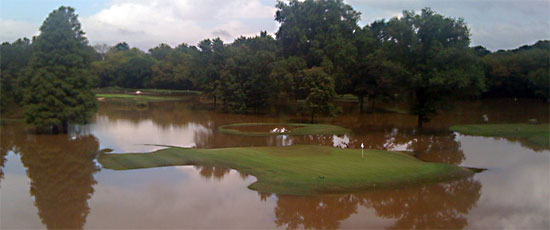
Wednesday, September 7, 2011.
|
Here are the latest shots of one portion of the damage and repair:
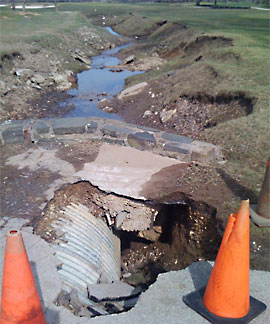
Before
|
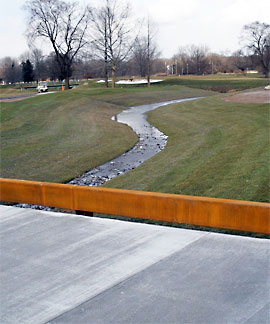
After
|
Check out more photos of the rebuilding of Whitemarsh Valley at wvccgreens.blogspot.com
|
 |
|
Shop ingenuity...
David Phipps, Stone Creek Golf Club, Oregon City, OR:
 "All winter the repair of the large Dakota topdresser had been looming over us, and this week Steve and I finally decided to see if there was a way we could repair it, instead of ordering a new conveyor box for the side shoot. Last fall the tractor jackknifed while topdressing the tees thus crunching the bottom end of the conveyor box. We checked the price on a new one and that was going to cost us close to $4K. If there is a way to repair it, I was confident Steve could find it. We sat there and stared at it for some time; then finally Steve had a plan and off he went.
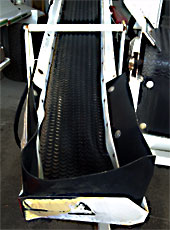
Twisted conveyor.
|
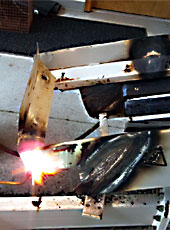
During repair.
|
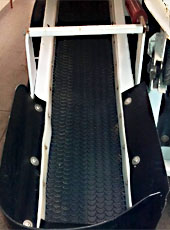
Good as new!
|
He started by cutting the bottom roller out of the box then he cut the seam at the corner. With a little heat he was able to bend the box back into shape and then he welded the roller back in place. Steve is a perfectionist and wouldn't be happy with just a simple fix. By the time he finished, he had new paint and safety stickers applied, and it looked as good as new.
I can't describe how happy I was to see it back together when I came back to the shop Friday after the Pro-Am. The side conveyor plays a vital role in our aerification program. Without it we would have to make multiple trips to the sand pile thus using an abundance of time and fuel. Great work Steve!"
Visit David's blog at stonecreeksuper.blogspot.com
|
 |
|
Trade show plunder...
Jim Alwine, Stockton Golf and Country Club, Stockton, CA:
 "A few weeks ago, our Equipment Manager, Jan Cariati and I went to Las Vegas to take in the Golf Industry Show. This was Jan's first GIS and she definitely made the most of it meeting with many equipment suppliers, researching new products, obtaining price information for upcoming projects, and joining the International Golf Course Equipment Managers Association. She also picked up bags full of souvenirs for the staff back at the course.
We do this every year. We take our fair share of the floor swag, hats, pens, bags, water bottles, and all kinds of trinkets to share with the staff. Upon our return, the lunch table looks like a disorganized garage sale. We pull the time cards and shuffle through to raffle off our plunder.
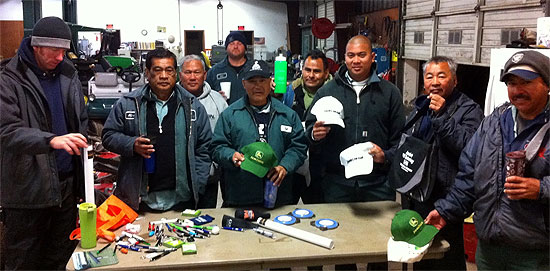
They were a little happier about it than the picture shows; they just don't like their picture taken. The John Deere hats are always the first to go. Thank you to all the vendors who put out these items, we give them to the people who make our course look good even when we are out of town."
Visit Jim's blog at sgccturf.blogspot.com.
|
 |
|
Growing Degree Days...
Steve Cook, Oakland Hills Country Club, Bloomfield Hills, MI:

"The life cycles and growth rates of many biological organisms are determined by temperature. As temperatures increase, activity increases. One of the ways we measure the biological activity of plants and insects is Growing Degree Days or GDD. Knowing the GDD allows us to monitor a specific number and apply plant protectants (like insecticides) at the appropriate time in an organisms life cycle to maximize control. It works for plants too, like crabgrass.
 What is GDD and how is it calculated? We assume that an organisms growth rate increases as the temperature rises above a predetermined base temperature. Each organism may be given a specific base temperature.
There are several methods to calculate GDD, but the most common is to subtract 50 degrees from the mean daily temperature. So, GDD = (Thigh + Tlow)/2 - 50. For a high of 80F and a low of 60F the GDD for that day would be: (80+60)/2 - 50 = 20GDD. Once the total GDD exceeds the organisms lifecycle threshold, treatments can be applied. Knowing these activity thresholds is important and we monitor them depending on our target pest and optimal treatments".
Visit Steve's blog at ohccturf.blogspot.com.
|
 |
|
Smaller collars = more green...
Brandon Collins, Country Club at Woodmore, Mitchellville, MD
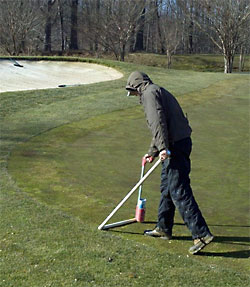  "You may have noticed the yellow dots in the middle of all of our collars around the golf course. We are in the process of reducing the width of our collars from 30” to 21”. There are several reasons for this. The mower that we use on our collars in 21” inches wide and previously, it was necessary to make two separate passes, overlapping in the middle, to mow the collars. We will now be able to make a single pass around the green, which will save us time during golf course setup. This practice should also result in improved turf health of the collars, as the middle of the collar will now receive half as much mower traffic. And the final benefit — MORE GREEN SPACE! Its not much, but if you are like me, every little bit helps."
Visit Brandon's blog at ccwoodmoregcm.com.
|
 |
|
Spring clearing...
Justin Gompf, Vail Golf Club, Vail, CO:
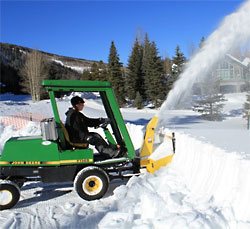 
"I began clearing greens on March 8. We are a little behind due to being short handed on staff but with the good weather we had last week I had to get out and see what was happening under the snow. So, Kirk has picked up a couple of grooming shifts for me and I’ve been working on clearing greens.
This is the first time I’ve appreciated the lack of powder days this year. So far I’ve been able to clear 2 and 3 completely and they look great. I was able to get 6 and 7 blown off but not completely shoveled. Seven looks good and I should be able to get it cleared by the end of the day Wednesday. Six on the other hand is going to be more work, as usual. It had several inches of water standing on it along with some ice. Luckily we have good weather through at least Friday and have plenty of time to get it dried out.
Overall clearing greens has gone well and they look pretty healthy. This weekend I’ll get some help as an intern will be joining us early to help get things ready this spring."
Visit Justin's blog at vailgcm.blogspot.com.
|
 |
|
About our Blog Aggregator: Many superintendents are now hosting private blogs to better communicate with their golfers and/or members. Beyond local weather and course conditions, there is a great deal of information about projects, methodologies and techniques that would be of value to other superintendents — hence our Turf Blog Aggregator. As every blogger struggles occasionally with content, we also include posts intended to educate golfers about turf maintenance for others to use as a template for their own blogs.
Miss any previous issues of TBA? You can find them all here.
Turf Blog Aggregator(TM) is a trademark of Turnstile Media Group.
|
|